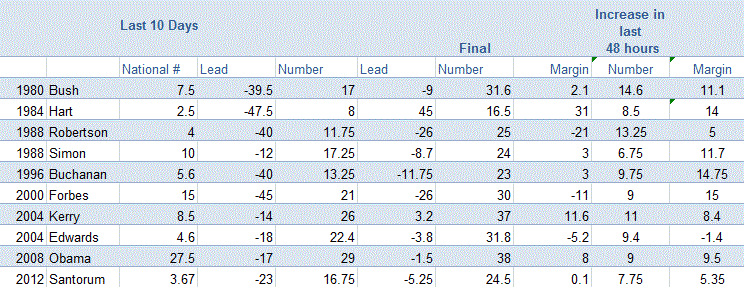Thanks to fladem for this historical perspective on late shifts in Iowa caucus-goers’ preferences. If you missed his earlier posts, check out A deep dive into Iowa caucus History and Iowa polling 45 days out: Let the buyer REALLY beware. -promoted by desmoinesdem
This is a continuation of an article I wrote about Iowa polling in November. At the time I noted how unpredictable the Iowa caucuses are. This article will to look at the last 48 hours. There are two lessons you can draw:
1. Front-runners beware
1. Expect someone to come from nowhere
The table below looks busy. But the lessons are easily summarized:
1. Since 1980, the leader’s margin has gone DOWN in ten of twelve contests in the last days before the caucus.
2. More importantly, when the leader in Iowa also leads nationally, their Iowa margin has gone done IN EVERY RACE.
Seven of these races involved a candidate who lead by significant margins nationally. Importantly, in the last few days in Iowa concerns about their candidacy created movement to an unexpected challenger. Let’s review some of these cases:
1980
It is difficult to remember perhaps, but the GOP establishment had significant suspicions about Reagan. At the same time, there were several establishment candidates who simply did not connect. Howard Baker ran second for most of the lead-up to Iowa, but was out of step with Conservatives. Bush emerged late, and beat Reagan.
It is difficult to talk about the effect on the race. Bush would take the lead nationally within days after the caucus.
There is an obvious parallel to the GOP race. The top two candidates as of this writing each have significant problems with the establishment. One, Donald Trump, has run the strangest campaign of my lifetime. Another, Ted Cruz, is attempting to occupy the space the winners of the last two Iowa Caucuses have occupied. But he has problems with the establishment as well.
Since 1988 anti-establishment candidates have emerged late in the GOP Caucus. But the lineup of candidates is different in 2016. One wonders if a candidate more aligned with the establishment will emerge late.
Democrats and the establishment
The 2016 race for the Democratic nomination is a fight between the ultimate establishment candidate and the ultimate outsider. At this writing it is close. Let’s look at two races and see if they can provide guidance.
2008
The relevance is obvious. In 2008 Clinton lead nationally and in Iowa late. It was a contested race in Iowa, always close. As has happened so often, in the last 72 hours the race broke away from the front runner. Clinton lead by 1 in late Iowa polling, but would lose by 8, and would find her final polling number to be nearly identical to the results she would receive in the caucuses.
Democratic Caucuses in Iowa re fundamentally different affairs than GOP Caucuses. Historically establishment Democrats do not collapse. In 1980 Carter’s numbers changed little, and Gore’s lead and margin held up as well.
That did not happen in 1980. In fact, 2008 can be viewed as an inflection point yet to be defined. In 2008 the establishment candidate did not hold her lead.
A fundamental question can be asked: does 2008 reflect a long term change in Iowa Democrats perception of their establishment?
2004
If 2008 stands for the proposition that the establishment was under siege, 2004 can be read in two different ways. In 2004 an anti-establishment candidate, Howard Dean, lead nationally. Dean collapsed late in 2004, and two candidates would make significant surges. John Edwards, who was below 10% a month before the caucus, and John Kerry, who a month out was in the low single digits, would both exceed 30%.
What is interesting is what they say about the establishment. Kerry was an establishment figure, aided late by Ted Kennedy. John Edwards was NOT a establishment candidate. Each rode surges to unexpected finishes.
So what do these races say? In some ways 2004 and 2008 stand for opposite propositions. One stands for the rise of the anti-establishment, another stands for the idea of the power of the establishment
Expect someone to come from nowhere. The table below is kind of amazing. It documents how many times a candidate has surged in the final days. Remember, these are candidate who exceeded their final polling by 10 or more points.
A large number of these candidates come from the non-establishment wing of the party. In almost every cycle since 1988 a candidate from the religeous right has surged late. They include:
1988: Pat Robertson
1996: Pat Buchanan
2012: Rick Santorum
In addition, Mike Huckabee outperformed his numbers late.
Clearly this gives hope to Ted Cruz. But it also may give hope to a candidate with an economic agenda as well. Steve Forbes went on to outperform his polling in 2000 by 15 points.
But the this table makes clear – someone in every cycle does far better than anyone expected. Who will it be in 2016?



No Comments